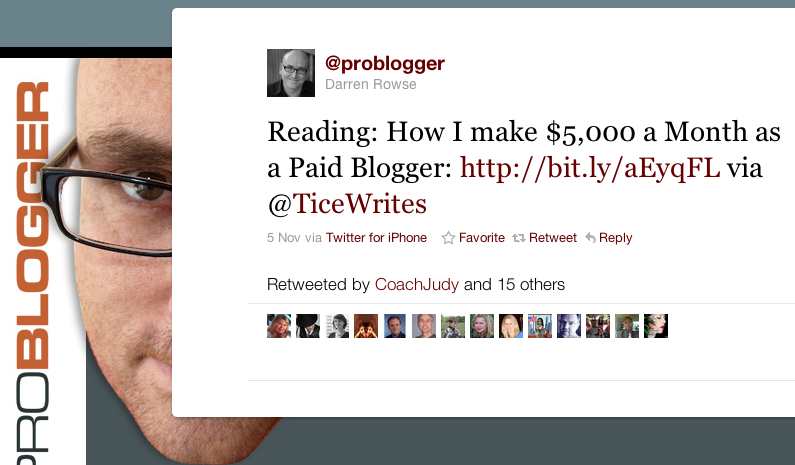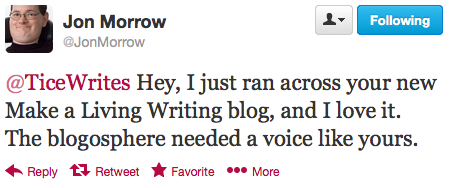
The question is: How do you get those better gigs? To get paid to blog (real money, that is), you need to show clients how the blog posts you write help bring in additional money.
A decade back, blogging was more of a ‘squishy’ soft-sell tactic than it is today. Now, companies increasingly understand how content marketing works. When it’s done right, blogging bring them more leads, opt-ins, and ultimately, sales. Which means they look to you for proof your posts will bring new business.
I’ve been getting a lot of questions about this challenge in Freelance Writers Den lately. So I thought my blog readers would probably like tips on this, too. In this post, I’ll give you concrete strategies for demonstrating the value of your paid blogging, even as a newbie.
Big tip: Don’t guarantee results to get paid to blog
Need to prove value as a paid blogger? It’s definitely a worry for freelance writers. For instance, here’s a question I recently got from a brand-new writer:
“I need info to back up pitches to business clients that I can ‘bring in more leads, increase awareness.’ Do business blogs tangibly work? And if so, how to ensure that? If I write great web content, will it attract customers?
“SEO best practices are always evolving, and my fear in launching this business is my writing won’t deliver on promises of increased sales. Or I’ll be asked for examples of ‘successes’ in this area.”
Business blogs definitely do work. Otherwise, businesses wouldn’t still be posting on them. If you want to get paid to blog, you will be asked for examples of your wins — and your job is to build those as fast as you can.
One other key thing to know in business blogging: Never guarantee results.
You get paid to blog for the effort you put into your writing, not on the contingency that the client get a particular result. Don’t fall into that trap.
Simply build your portfolio. Show your experience in driving traffic and getting visitors to take desired actions (social share, comment, opt-in for a free report, sign up for a course, etc.).
Here are five approaches that will help you quickly build a track record, show your value, and get paid to blog for big money (even if you’re a newbie):
1. Screenshots of social proof
Even before you have a single client, you might be guest-posting for free, or writing on your own blog. Anytime you have a popular post, take a screen shot of the share or comment count. A post that got hundreds of views, comments, tweets, or Facebook shares helps get prospects excited about what your writing could do for their business growth.
For instance, some of my early social-media wins were guest posts on Copyblogger.
They no longer show share counts with their social-share tool…but they do show number of comments. And comments are also a strong piece of evidence that you can write posts that make readers take action: They left a comment.
If prospective clients ask if you know how to get readers engaged, that’ll do as proof.
If you don’t have a steady history of successful posts, a screenshot of one popular post can also be highly persuasive, especially on sites that show a view count:
My pro tip: Take a screenshot right away, any time you see good traffic or social stats on one of your posts.
When companies change sharing tools, counts often get reset back to zero. Or companies fold or reorganize their content, and the next thing you know, your big win has vanished. Preserve the evidence, and you’ll have social proof to help land a new client and get paid to blog.
2. Let your testimonials sell
It’s frustrating if your client won’t share stats with you, so you can quantify how your posts did. The next best thing is to harvest a testimonial from them, ideally one that mentions a specific win or two. Something along the lines of:
“Carol’s blog posts helped us double our monthly traffic and grew our list by 1,000 names.”
OR
“Carol’s post on the top 10 tools was our most popular this year.”
Of course, it would be better to have actual stats, and to be able to tie that directly to downloads, opt-ins, or sales figures on a specific campaign.
3. Get stats and take screenshots
Even if you have a paranoid client who doesn’t want to give you dashboard access where you can roam around and get tons of data, there are ways to get at least a bit.
If you can’t get access to all their stats, ask your client to give you one or two key facts.
For instance, ask:
“Which of the 10 posts I’ve done got the most traffic? Could you tell me what views were on that one?
“How did my post rank among all this month’s posts?”
“Can you tell me what the top three post headlines were that I’ve created, and their traffic?
“Do you see any trends in topics I’ve done that are doing well for us?”
You can spin this as “I’m just trying to improve and help you succeed here.”
A little data — or even a narrative answer about your success — that you can show new prospects is far better than no proof at all that your posts are effective.
One possible way to gather data: On many popular blogs, they offer you a home page for all your posts on the platform. That may have traffic stats. For instance, I’ve been able to get paid to blog by simply showing prospects the stats from my Forbes channel:
Obviously, I’m not directly selling anything on this editorial channel. But driving 2.5 million visitors with just 165 posts still makes a strong case that I know how to get eyeballs on a post.
4. Propose trackable projects
When you’re new to business blogging, you’ll often have clients who don’t know much about conversion. They may not be withholding data from you — they may just not have any!
So be a genius and propose a post that has a valuable download in it, or a P.S. that links to an offer for a paid product or service.
The secret? Suggest they set up a unique page that is only linked from that post. That way, they can track clicks to that page and see how the post performed compared with other ways they promote the same offer, or with past promotions of that offer.
Be sure to circle back and ask them for data after the campaign, so you can document the sales or opt-ins you got.
5. Pitch relationship building
If you don’t have any sales victories or impressive shares or traffic stats to report, consider a different angle. Instead, talk about how your post ideas could help grow their network of influencers, or build rapport with readers by delivering high value.
If you’ve ever gotten a big influencer to share your post or otherwise mention you in a positive way in a social comment, screenshot that! (And if you haven’t, work on it by targeting post ideas they’d love directly to them.)
Here are a couple of those that I’ve held onto, to show around as far as driving traffic on this-here blog:
If the many marketer emails I get each week asking me to share their company’s posts are any indication, influencer marketing is of huge interest right now. Demonstrate that you’ve had well-known names share your post or mention you, and you’ve shown you know how to build buzz for a blog. And that buzz leads to sales.
Commonly, some posts in a content marketing campaign simply build rapport with readers and deliver value. Those purely useful posts help future salesy posts be more successful. You can always talk up how valuable content builds authority with their audience.
Can’t get traffic? Get help
One final tip: If you’re struggling to get traffic on your paid blog posts, ask for help from the client. Learn what has done well for them in the past, and it may open the doors to success for you.
When I started out with that Forbes channel I showed above, my posts were mostly being ignored. I asked if my editors could help me succeed with their audience.
That request got me a one-on-one coaching session from a top online editor. After I got those tips, I wrote different types of posts, based on what was proven to work for their audience — and my traffic took off.
How do you show value to blogging clients? Let’s discuss on Facebook or LinkedIn.















